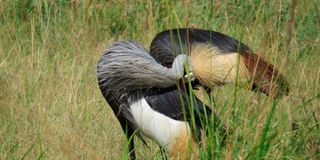Powerline threat to Grey Crowned Crane survival

Grey Crowned Crane in Nairobi National Park 4 June. PHOTO | RUPI MANGAT
What you need to know:
- Today, the Grey Crowned Crane, “only found in sub-Saharan Africa” is on the Coat of Arms and flag of Uganda.
- Crane crusaders Wanyoike Wamiti and George Muigai who monitored cranes around Lake Ol’ Bolossat in Nyandarua County for close to a decade are concerned about their existence in the wild.
The Grey Crowned Crane is loved in the region. Tall and stately, it was once common in rural areas around homesteads and in fields, farms and swamps until mid last century (1950s).
Today, the Grey Crowned Crane, “only found in sub-Saharan Africa” is on the Coat of Arms and flag of Uganda, and part of the emblem of the Makerere University, Kisii University in Kenya, the University of Nairobi and County of Nairobi.
But all is not well with the iconic bird.
Crane crusaders Wanyoike Wamiti and George Muigai who monitored cranes around Lake Ol’ Bolossat in Nyandarua County for close to a decade are concerned about their existence in the wild.
Wamiti, who has 34 years’ experience as a research scientist, says Kenya has lost 758 Grey Crowned Cranes annually between 1986 and 2019, a loss rate outpacing the survival rate.
In 1986, there were 35,000 Grey crowned cranes and by 2019, they were 10,000. The cause of the decline is due to emerging threats such as poisoning and erection of electricity power lines. Even flightless chicks die from getting entangled in barbed wire fences and snares.
The natural habitat of the crane has been encroached upon: the grasslands it forages on has been turned into farms and the swamps where it lays its eggs are now crowded by livestock who trample on their nests. The tall trees it roosts on have all been felled by human activity, leaving the birds homeless.
In Kenya, 95 percent of cranes are outside protected areas like national parks forcing conservation efforts to be extended to where they live. This has given rise to community-based organisation like the Cranes Conservation Volunteers and private landowners, who use the Wildlife Conservation and Management Act of 2013 to protect the species.
Although all power lines have been approved by way of environmental impact assessment reports show that they are not in the way of wildlife, on the ground things are different.
Projects like the Loiyangalani on the Lake Turkana shore and the Ethiopia/Moyale are in the flight path of birds.
Wamiti says; “We need to identify the hotspots, make the lines more visible to animals so that they can avoid the lines or make them safe by installing insulated cables or even revert to using underground cables. There is a wealth of information from our partners across the globe who have dealt with this.”
The recent nationwide wildlife census did not count the Grey Crowned Cranes and other avifauna.
Monkeys and giraffes are also affected and reports showed endangered Rothschild giraffes electrocuted by misplaced, low hanging power lines in a wildlife conservancy in Kenya.




